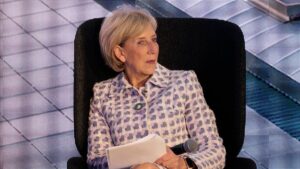Canberra reckons Iluka Resources’ rare earth refinery will build a local supply chain, but is it a good bet?

Pic: Getty
- ScoMo and Co. approved up to $1.25b in funding via a low-cost non-recourse loan to support the Eneabba refinery in Western Australia
- Local executives have queried why the Government would use its critical mineral facility to back a company as big as Iluka
- Focusing on one specific component is part of the solution but understanding the full supply chain and is arguably more important
Canberra is taking a big, taxpayer funded punt to help Iluka Resources (ASX:ILU) build a new $1.2 billion rare earths refinery in WA, but the jury is out as to whether it’s a bet worth taking.
ScoMo and Co. approved up to $1.25b in funding via a low-cost non-recourse loan to support the Eneabba refinery in Western Australia through Export Finance Australia (EFA) from its Critical Minerals Facility, a fund set up to bankroll a local critical minerals supply chain.
With first production due in 2025, it’s the third project to benefit after funds were announced for EcoGraf’s (ASX:EGR) Australian Battery Anode Material Facility in Kwinana and Renascor Resources’ (ASX:RNU) integrated Siviour graphite mine and processing facility in South Australia back in Feb.
In responses to questions from Stockhead, Federal Resources Minister Keith Pitt said the refinery grant “strongly aligns with the objectives of the Government’s Critical Minerals Strategy”.
“The project will advance the development of Australia’s sovereign critical minerals processing capacity, and help to further establish Australia as a major supplier in the rare earths market,” he said.
“In addition, the project will establish Eneabba as a rare earth processing hub for more deposits across Australia. This will lower cost and reduce risks, helping other projects get to market.”
But experts say the jury is out on whether Eneabba will deliver the local rare earths supply chain the election bound Feds claim.
Is it the right project to support?
Federal Government loans to mining companies don’t always work out for the best, see for instance the collapse last year of Salt Lake Potash.
There is a broad recognition we need to develop more critical minerals resources in our local supply chain especially in rare earths, where more than 80% of the downstream market is dominated by China.
One of the reasons Canberra is so keen to back Iluka, better known as one of the world’s leading producers of mineral sands, is that down the line the refinery could process third party feed, opening the development of stranded resources by junior miners.
Iluka boss Tom O’Leary told analysts on a conference call earlier this month the company not only wants to process third party concentrates and enable the development of the rare earths industry in Australia, but also wants the plant to be “meaningful globally”.
“I’m confident that over time, we will enter into arrangements with third parties around concentrate supply,” he said.
However, some local executives have queried why the Government would use its critical mineral facility to back a company as big as Iluka, calling the award of the EFA funds for a loan of this nature “unusual and unique”.
In some ways, ASX companies are all competing for capital to be the next project in the market, but the question remains as to whether a $5bn market cap company needed the entire $1bn funding for a resource made up of monazite concentrate.
Monazite is a by-product of mineral sands processing and Eneabba is the highest-grade source of light rare earths neodymium, praseodymium, terbium, and dysprosium globally, the stuff used in permanent magnets in a wide range of technologies such as electric vehicles, clean energy generation and defence.
Iluka’s refinery aims to produce these separated light and heavy rare earth oxide products, which will initially be fed by stockpiles of monazite concentrate from the Mid-West Eneabba mine before ramping up to take concentrate from Iluka’s Wimmera deposit in Victoria and potentially third-party feed from other local producers.
While concentrate from Eneabba will only take up 24,600t of plant capacity a year, the plant will be designed with a capacity to take 55,000tpa of rare earths concentrate with a total rare earths oxide production rate of 23,000tpa and NdPr production of 5500tpa.
An Iluka spokesperson said the refinery will be a “multi-generational asset for the downstream processing of Australia’s rare earth resources.”
That includes nine years of stockpiles from Eneabba – included as part of the company’s equity contribution – and provides a processing route for Wimmera and the “not insignificant” by-product credits of monazite and xenotime from its Balranald rutile, zircon and ilmenite deposit.
“So the refinery has been designed specifically to provide flexibility and optionality in relation to supplementary feed sources, both from within Iluka’s portfolio and from potential third parties (i.e. mineral sands and rare earths producers),” the spokesperson said.
“Phase 3 is not an opportunity without risk for Iluka. The partnership we have agreed with the Australian Government mitigates risk in a way that recognises the substantial contributions of both parties.
“Terms of the risk sharing arrangement reflect Iluka’s unique stockpile contribution; Phase 3’s strong alignment with the Commonwealth’s Critical Minerals Strategy; and significance as Australia’s first fully integrated rare earths refinery.”
Metallurgy of different projects could be a challenge
However, Hasting Technology’s (ASX:HAS) chief financial officer Matthew Allen questions whether Eneabba is the best project the government could have chosen to support.
“From a broad perspective, the stated aspiration by the Australian government through the critical mineral strategy is they want to build capacity and capability in the downstream manufacturing elements and build supply chain resilience in critical minerals,” he says.
“They are all consistently stated strategies of the Australian government and consistent with the broader desire globally to build this independent critical mineral supply chain.
“But from an individual project perspective, is it the best project that the government could choose to support? It’s clearly going to be reliant on third party supply into that facility and the challenge I think is that the metallurgy of individual projects is different.”
While the plant will support monazite processing flows, Allen says it would not be a process flow that is suitable for all product types to push through.
Only mineral sands and rare earth companies that have monazite would be able to use the plant, unless other plants produce their own mixed rare earth carbonate.
It is still very early days to tell where each individual rare earths explorer or developer fits in – Meeka Gold’s (ASX:MEK) Tim Davidson says metallurgical testing would need to be undertaken to see if their product can be fed into the Iluka plant before making the decision as to whether entering into a commercial relationship with Iluka is the best outcome for them.
“Iluka has rare earths that are hosted in mineral sands, recovery of the valuable elements in their case is more akin to processing the hard rock style rare earth deposits than it is to what we see on our tenure, which is rare earths hosted in clay,” he said.
“Some of the processing steps Iluka has incorporated into their refinery we would likely not require – for us it would be working out if there is a way to feed our product into the back-end of the plant, which isn’t a bad thing, it would make it a lot easier and cheaper to process but we need to do that work to understand it and understand if there is an opportunity for us to provide feedstock for this plant.”
Construction and technical hurdles
As well as being extremely capital intensive, hard rock rare earths plants are often faced with major construction and technical hurdles, too.
Take for example Lynas’ (ASX:LYC) rare earth separation plant in Malaysia, which was meant to be built in 2011.
After the plant fired kiln with concentrate at the end of 2012, it then took Lynas until the first quarter of 2017 to exceed production design rates – meaning the company spent four years ramping the plant up to full capacity… during which time the rare earths market tumbled.
It has also attracted criticism for its production of radioactive waste, inviting stoppages to production and a demand from Malaysia that it cease importing radioactive ores.
Still, global demand for rare earth elements has increased drastically over the past two decades with the wind energy industry driving growth in the use of rare earth magnets, which are three times stronger and 1/10th the size of conventional magnets.
Wind turbines can use up to two tonnes of rare earth permanent magnets, providing better electrical yield, reduced maintenance and improved reliability.
And again, in understanding the rare earth supply chain one of the biggest factors holding the development of rare earths projects back is that much of the processing capability doesn’t exist outside of China.
From this point of view, Ionic Rare Earths (ASX:IXR) managing director Tim Harrison says Iluka’s move is smart but represents only part of the solution.
Next steps of the supply chain
“What Western governments need to think about is who’s building the next step in the supply chain? What companies are pulling the capability to turn oxides into metals, alloys, and magnets which then go into individual components such as EVs, wind turbines and F35s for example?” Harrison said.
“It’s one thing to mine the individual elements and another thing to refine them to purity to then go into value added products, but just focusing on building a mine or a cracking and separation plant, or a refinery in isolation is to some degree, a bit of a trick.
“The entire supply chain needs to be built and focusing on one specific component tends to suck people in, when a greater understanding of the full supply chain and complementary downstream processing to make the product needs to take place.”
This is poorly understood across the investment community and by governments, Harrison says.
“Building a supply chain is going to require numerous individual steps within the time-frame required to meet government sanctioned target dates on the phasing out of internal combustion engines and facilitating the move towards EVs.
“It’s not going to be an easy exercise – it requires a greater understanding of all the individual components that make up the supply chain,” he said.
“Where we have seen strategic investors and partners focusing their efforts is on the individual elements rather than ‘rare earths’ – what are the projects that move the needle on the supply of elements that we need.
“It’s difficult to find those projects with the right balance.”
KTA placed in the ‘box seat’
For others in the game, such as rare earths explorer Krakatoa Resources (ASX:KTA), Iluka’s Eneabba refinery represents a meaningful option.
Previous explorers, namely BHP, have commented on “extraordinary high monazite” over Krakatoa’s area of interest at Dew on the Northern margins of the Yilgarn Craton in Western Australia.
“The good news for KTA shareholders is not only do we have iron absorption clay REES that we can process, we also have a facility down the coast where we can potentially sell our monazite to,” KTA chairman Colin Locke said.
“We haven’t officially made the discovery yet but BHP and other explorers have commented on the high-grade nature of the monazite when they were looking for diamonds around 30 years ago.
“They called it ‘abundant monazite’ which means up to 50% monazite and could provide another potential revenue source assuming there is a resource there.”
Plans are in place to get rigs out on the Dew site this year in hopes to make a monazite discovery, Locke says.
“Why haven’t we done it before? Well because this plant wasn’t planned, but now that the plant is set to come online in 2025, that couldn’t be better timing for Krakatoa, assuming we make the discovery, which I believe we will.
“It pus us in the box seat – by that time we would expect to have a fairly significant resource.”
Rare earths share prices today:
At Stockhead, we tell it like it is. While Krakatoa Resources, Meeka Gold and Ionic Rare Earths are Stockhead advertisers, they did not sponsor this article.
Related Topics

UNLOCK INSIGHTS
Discover the untold stories of emerging ASX stocks.
Daily news and expert analysis, it's free to subscribe.
By proceeding, you confirm you understand that we handle personal information in accordance with our Privacy Policy.








